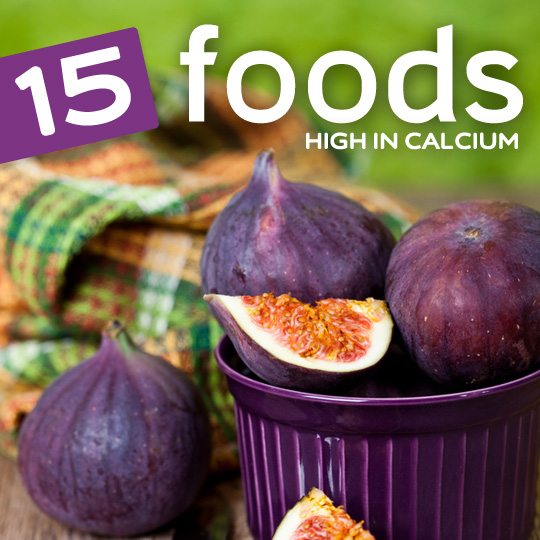Getting your recommended calcium for the day is important, and these high calcium foods can help get you there. It helps support healthy teeth and bones and it also plays a part in overall body weight, with anti-inflammatory and heart health benefits as well. There’s simply no reason to let your calcium level dip too low, because there are plenty of delicious foods to help you keep it up.
[hr]
[column size=”one-third”]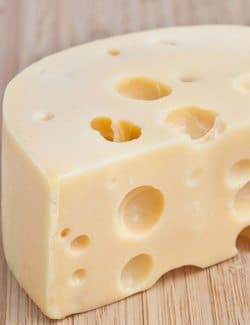 [/column]
[/column]
[column size=”two-third” last=”true”]
1. Cheese: 1,045mg Calcium (105% DV)
Cheese is one food that has some healthy benefits to it, but it also contains fat and cholesterol, and sodium. It takes the number one spot in terms of calcium, and far outdoes any other food in calcium, once for once.
Cheese is also high in protein, which helps keep you satisfied after a meal. It also contains Vitamin A and Vitamin B12, important vitamins for your immune system and energy levels, respectively.
You’ll find cheese in and on so many different dishes, that you may find yourself trying to figure out how to avoid it rather than having to seek it out. As long as you balance the healthy things cheese brings with the unhealthy it can be used as part of a healthy diet to increase the flavor of a meal.
Tips for eating more: You don’t want to go too heavy on the cheese, while it does provide you with plenty of calcium, many cheese varieties are high in fat and cholesterol.[/column]
[hr]
[column size=”one-third”]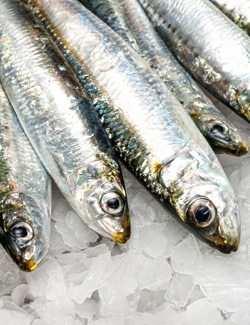 [/column]
[/column]
[column size=”two-third” last=”true”]
2. Sardines: 382mg Calcium (38% DV)
Sardines take the number two spot on our list of high calcium foods, and while they may not be at the top of everyone’s shopping list, they can be added as an edible garnish or mixed into soups for added calcium and other minerals.
Sardines also rank high in omega-3s, which may be a more intriguing reason to eat them than the calcium they contain. Omega-3s have been credited with everything from preventing heart disease, to increasing heart health, to reducing inflammation in the body.
In addition to the omega-3s and calcium you’ll be getting protein from the sardines, which helps you build lean muscle and keeps you feeling full longer after a meal.
Tips for eating more: Sardines are generally found You can try them as a pizza topping similar to anchovies, or incorporate it into a side dish. It’s hard to make a meal out of sardines because of their small size and strong taste, but you don’t need to eat too much to get the benefit of the calcium they contain.[/column]
[hr]
[column size=”one-third”] [/column]
[/column]
[column size=”two-third” last=”true”]
3. Tofu: 350mg Calcium (35% DV)
A 100 gram serving of tofu gives you more than a third of the calcium you need for the day, earning in the number 3 spot on our list of foods high in calcium.
Tofu is also a good source of non-animal protein, and has a similar texture to meat making it a good candidate for a meat replacement in hundreds of popular dishes. It also contains a generous amount of iron, so you’re getting multiple benefits from eating it.
It’s interesting to note that tofu contains more calcium, ounce for ounce, than the soybeans it comes from. The process of making tofu involves using calcium sulfate to help it keep its form. Tempeh offers a similar benefit, but only provides 11% of your daily value to tofu’s 35%.
Tips for eating more: Replace a meat dish one or two times a week with a tofu dish. It’s long been used by vegans and vegetarians to provide protein, but it also provides other vitamins and minerals, like calcium.[/column]
[hr]
[column size=”one-third”] [/column]
[/column]
[column size=”two-third” last=”true”]
4. Almonds: 264mg Calcium (26% DV)
Almonds and other nuts provide so much calcium that they rank in the top 5 of our list. The impressive feature of almonds is that they’re often regarded as being healthy, but seldom get referenced for their calcium content.
Almonds contain plenty of fiber as well as healthy fats, which why they’re so good at helping to make a meal satisfying, or used as a snack when you start feeling hungry long before meal time.
Other nuts that could have made our list but that get filed under almonds are pistachios, pecans, hazelnuts, and more. Chances are most any nut you choose will contain at least some calcium, if not enough to make the cut-off for our list.
Tips for eating more: A handful of almonds makes a great snack, and also provides you with protein and fiber, a big reason why it does such a good job of curbing your appetite until your next meal.[/column]
[hr]
[column size=”one-third”] [/column]
[/column]
[column size=”two-third” last=”true”]
5. Collard Greens: 232mg Calcium (23% DV)
Collard greens outrank popular leafy greens like spinach and kale in the calcium department, and they deserve a spot on your plate if you are looking for an overall nutritious vegetable that you might have been overlooking.
Collard greens are a good source of dietary fiber, as well as vitamins A and C. They are naturally low in sodium and fat, and are a great way to keep your diet varied instead of always turning to the same vegetables again and again.
You can use collard greens as part of a detoxing program to help rid the body of harmful toxins. They’re best eaten in the spring and summer months, which just happens to be the best time of year for cleansing.
Tips for eating more: Try subbing in collard greens for spinach or kale to keep things interesting. They provide a different flavor than these other greens, but still gives you many of the benefits, including a respectable amount of calcium.[/column]
[hr]
[column size=”one-third”] [/column]
[/column]
[column size=”two-third” last=”true”]
6. Figs: 162mg Calcium (16% DV)
Figs score big in regards to calcium department, but you’ll need to go with dried figs in order to get these benefits. Dried figs have a higher concentration of everything fresh figs contain, including calcium, potassium, fiber, and sugar.
Figs can help you bring your blood pressure down thanks to the potassium they contain. They are also a rich source of fiber, to help keep you regular, and keep you at a healthy weight thanks to an improved digestive system.
Dried figs, like most dried fruits, contain a high amount of sugar. While this isn’t the same as the refined sugar you find sold in big bags at the store, it’s still something you’ll want to keep an eye on, as sugar that isn’t burned off may end up turning to fat.
Tips for eating more: Dried figs can be added to a salad, and make a delicious and portable snack.[/column]
[hr]
[column size=”one-third”] [/column]
[/column]
[column size=”two-third” last=”true”]
7. Arugula: 160mg Calcium (16% DV)
Arugula takes a backseat to kale in spinach as far as getting the limelight, but it bests them in calcium content by a nose. You can start using more arugula today and find out if its taste is pleasing to your palate.
Like many of the vegetables on our list, you’re not just getting a calcium food here, but a well-rounded item to add to your healthy eating. It’s filled with fiber, some protein, and other important minerals like magnesium and potassium.
Arugula is off the charts in terms of Vitamin A and Vitamin C, two important vitamins that have an antioxidant effect on the body. Overall this is one healthy green you should definitely add to the cart next time you’re in the store.
Tips for eating more: Arugula is often seen as a specialty green, and can be used to spruce up a spinach or kale salad. You can also use it as a garnish for a main dish, since it has an elegant, curvy appearance.[/column]
[hr]
[column size=”one-third”] [/column]
[/column]
[column size=”two-third” last=”true”]
8. Kale: 150mg Calcium (15% DV)
You’ve probably heard how healthy kale is by now, and its calcium content is just one of the attributes that put it on the radar of health enthusiasts nationwide.
You can feel good about eating kale because it provides you a little bit of a lot of things you need. It contains some protein, not as much as animal sources, but for a vegetable it’s respectable. It contains minerals like magnesium and potassium, and of course calcium. It’s also a good source of iron and fiber.
Kale is also part of the cruciferous vegetable family, and like many other family members it’s shown to have anti-cancer benefits.
Tips for eating more: Kale can be used wherever you’d normally use spinach, either as the base of a salad, in a green smoothie, or in a soup. It’s an easy and delicious way to get more calcium into your life.[/column]
[hr]
[column size=”one-third”] [/column]
[/column]
[column size=”two-third” last=”true”]
9. Milk: 119mg Calcium (12% DV)
Milk is often touted for its calcium content, along with its Vitamin D, but as we see here it barely makes it into the top ten for calcium, which just shows how high the other foods are in this mineral.
Milk is also a good source of protein, and gets credit for its Vitamin D. It has been linked to building muscle and helping with weight loss, and can even help to lower cholesterol levels.
You’ll want to check for lactose sensitivity before upping your milk intake. Many adults have at least a lactose sensitivity that’s gone undiagnosed. Try an elimination approach by removing dairy from your diet for at least a week, and then reintroducing it to see if your digestion worsens.
Tips for eating more: A glass of milk can be used as a snack to get you through to lunch or dinner, or you can use milk in your cooking and baking to increase the calcium in your meals.[/column]
[hr]
[column size=”one-third”]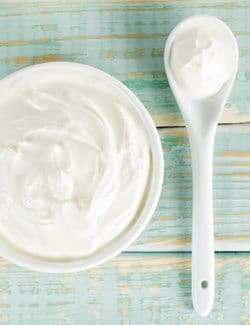 [/column]
[/column]
[column size=”two-third” last=”true”]
10. Yogurt: 110mg Calcium (11% DV)
Yogurt has just a bit less calcium than milk, and shares similar attributes, like providing protein and actually outdoes milk as far as protein goes. It’s also a good source of Vitamin B-12, which can help the nervous system.
Yogurt is often pitched as a probiotic, and there are even specialty yogurts you can buy that are supposed to accentuate this quality with added live cultures. But even regular yogurt has enough probiotic bacteria to aid in digestion.
Correcting digestive issues can play a big part in how easy it is to lose weight, how light and active you feel, and can help prevent long term or chronic disorders of the digestive system.
Tips for eating more: Use yogurt as a healthy snack that can help your digestion thanks to the probiotic bacteria it contains. Go with Greek yogurt and you’re also getting a good amount of protein to help satiate you.[/column]
[hr]
[column size=”one-third”]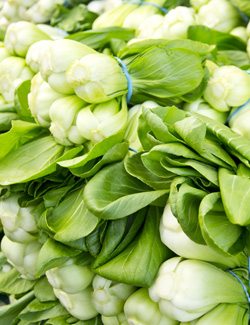 [/column]
[/column]
[column size=”two-third” last=”true”]
11. Bok Choy: 105mg Calcium (11% DV)
Bok choy is a form of Chinese cabbage that will contribute greatly to your overall calcium intake. A 100 gram servings gives you more than a tenth of the calcium needed, making it that much easier to get your total recommended value.
Bok choy, like regular cabbage, provide an assortment of vitamins and minerals, as well as fiber, making it a healthy addition to any meal.
It’s particularly high in Vitamin A and Vitamin C, so it will provide a boost to your immune system. It’s virtually fat free and very low in sodium, so it only has good things going for it, and only acts as a beneficial food for the body.
Tips for eating more: Bok choy makes a great side dish, and assembled our favorite bok choy recipes that show you how to make it in a number of ways to easily increase your bok choy intake, as well as your calcium numbers.[/column]
[hr]
[column size=”one-third”]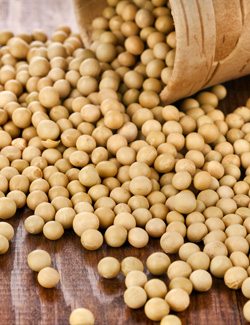 [/column]
[/column]
[column size=”two-third” last=”true”]
12. Soybeans: 102mg Calcium (10% DV)
Soybeans are one way to get your calcium level to where you want it. They contain more calcium than any other legume, and provide additional benefits like protein and fiber that make them a very healthy choice on most diet plans.
How you cook your soybeans matters, for example roasting the soybeans keeps their protein and fiber intact, while boiling them causes the nutrition level to drop significantly.
Processing soybeans has varying results, with tofu having considerably more calcium, and tempeh also ranking as a high calcium food. You’ll want to watch your intake of soybeans and soy products, as they contain phytic acid that can negatively affect the digestive system.
Tips for eating more: Soybeans can be cooked up just like beans and lentils, or you can go with a raw version like edamame, or a processed version like tofu or tempeh.[/column]
[hr]
[column size=”one-third”]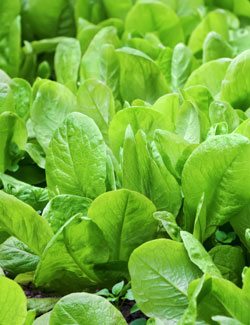 [/column]
[/column]
[column size=”two-third” last=”true”]
13. Spinach: 99mg Calcium (10% DV)
Spinach shows up on more of our healthy foods list than any other food, and it’s no surprise to find it on our list of high calcium foods because it gives you 10% of your calcium from just a 100 gram serving.
With some foods it might be hard to eat 100 grams of it to give you the advertised milligrams of calcium, but with spinach it is not hard to have a salad or a green smoothie and be one big step closer to having your calcium needs met.
Spinach provides a balanced array of minerals and vitamins, which has rightfully earned it a reputation for being a healthy food. It pushes the body toward alkalinity, helps curb inflammation, provide antioxidants to help the body’s fight against free radicals, and even provides some protein and fiber for good measure.
Tips for eating more: The easiest way to start eating more spinach is to jump aboard the green smoothie trend. Adding spinach to a smoothie instantly gives it the signature green color, but loads you up with phytonutrients as well as calcium.[/column]
[hr]
[column size=”one-third”] [/column]
[/column]
[column size=”two-third” last=”true”]
14. Okra: 82mg Calcium (8% DV)
Even though okra falls toward the bottom of our list, it’s important to remember that these are foods with the most calcium. So while it may not have enough to take the top spots, but it still has a respectable amount of calcium.
It’s also important to remember that there are several foods that didn’t make this list, but still contain some calcium. Consider it a team effort and try to eat as many different foods as you can to make your calcium quota for the day.
Okra may be one of the healthiest foods you’re probably not eating. It has plenty of fiber, folates, vitamins, and minerals that help your body in a number of ways. Adding it to your menu just once a week helps provide variety in your diet, and gets you closer to many of your nutritional goals.
Tips for eating more: If you’re stuck on ways to prepare okra, you can do a search for okra recipes and be introduced to a ton of ways to make okra into a side dish, or incorporate it into your main meals. It’s high in fiber as well so it’s worth getting to know.[/column]
[hr]
[column size=”one-third”]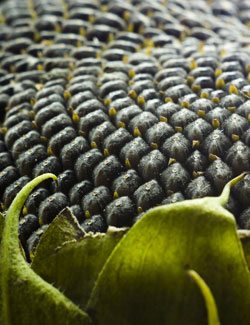 [/column]
[/column]
[column size=”two-third” last=”true”]
15. Sunflower Seeds: 78mg Calcium (8% DV)
Sunflower seeds will not only give you a decent amount of calcium, they’ll also provide you with protein and fiber, which help keep you from getting hungry when it’s not time for a meal.
The healthy fats in sunflower seeds are pretty impressive. Even though they are made up of 51% fat, the majority (82%)of that fat is healthy, being comprised of monounsaturated and polyunsaturated fat.
You’re getting big amounts of potassium and magnesium when you have sunflower seeds, and they also contain selenium. On a side note, they offer a satisfying crunch and a nutty flavor that can help you stick to a healthy eating plan.
Tips for eating more: These make a great snack, and you can opt for them in the shell or shelled. If you get the kind in the shell make sure they’re unsalted to keep your sodium level in check.[/column]



